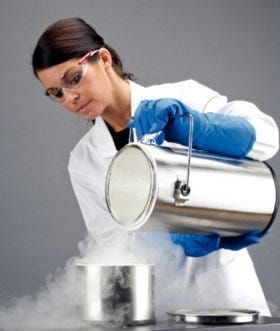The cryoprotectant your lab selects for long-term storage of both eukaryotic and bacterial cell storage can have profound implications for future experimental results. Cryoprotectants, literally “to protect cells and tissue from damage due to freezing,” can be man-made, or generated in nature. For example, some species of plants and animals produce substances with anti-freeze properties to help them survive cold environments. The sugar trehalose is one such compound, and is being tested as a cryoprotectant option for lab use.
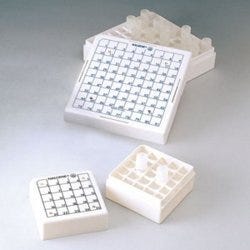
Vial boxes for cryogenic storage
These cellular guardians are generally formulated with other substances such as distilled water, ethylene glycol and/or bovine serum to create an ideal recipe for freezing. Cryoprotectants are categorized into two classes: extracellular and intracellular. Extracellular cryoprotectants are non-penetrating molecules that function by reducing hyperosmotic cell lysis that occurs
during the freezing process. Intracellular cryoprotectants penetrate the cell membrane and prevent the formation of ice crystals, which rupture cell membranes. Here we discuss the implications of using these solutions in cryopreservation of nucleus/organelle-containing eukaryotic cells, and more simply structured bacterial cells.
Extracellular Cryoprotectants
Extracellular cryoprotectants do not penetrate the membrane of a eukaryotic cell or the bacterial cell wall. For this reason, they are incapable of preventing cell membrane rupture that occurs as a result of intracellular water-crystal formation. Examples of these non-penetrating molecules are sucrose, dextrose and polyvinylpyrrolidone (PVP).
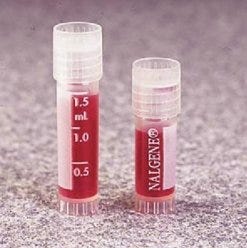
Vials with cell sample and cryoprotectant
Instead, these molecules function to reduce hyperosmotic gradients that form as the samples transition through the freezing process. As less water is available to function as a solute outside the cell, salt concentrations drastically increase. The increased osmotic pressure on cells cause alterations in cell shape, cellular interactions, subcellular distribution of molecules and ultimately cell viability.
The presence of extracellular cryoprotectants serves to balance the osmotic pressure differential and prevent the efflux of water from the cell. And, since these molecules do not penetrate the membrane, they do not have a direct, detrimental effect on cellular physiology.
Intracellular Cryoprotectants
Intracellular cryoprotectants, such as dimethyl sulfoxide (DMSO) and glycerol, have become mainstay reagents for cryopreservation. Both of these molecules have the ability to penetrate the cell membrane to reduce the formation of water crystals within the cell during the freezing process. To maintain cell viability when using these reagents, the freezing protocol must be slow and controlled, allowing the efflux of water to occur.
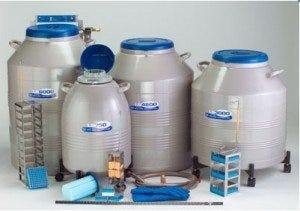
Insulated cryogenic containers for storage of cell samples
If the process is too rapid, ice crystals within the cell will form before the water is able to exit the cell.
While DMSO and glycerol have been traditionally used for the cryopreservation of eukaryotic and bacterial cells respectively, there are still disadvantages to this approach. In some instances these two molecules have inverse effects on the same protein. In addition, different cell types have different permeability for these molecules. This difference affects the rate at which a cell shrinks and swells before freezing, during freezing, and during thaw cycles. This can have a dramatic impact on cell viability.
Thus, one needs to pay close consideration to the type and concentration of cryoprotectant being used. A careful analysis of literature regarding standard operating procedures for your cell type and small scale experimentation can save the frustration and cost of having to repeat lengthy experimentation as a result of poor cryopreservation conditions.
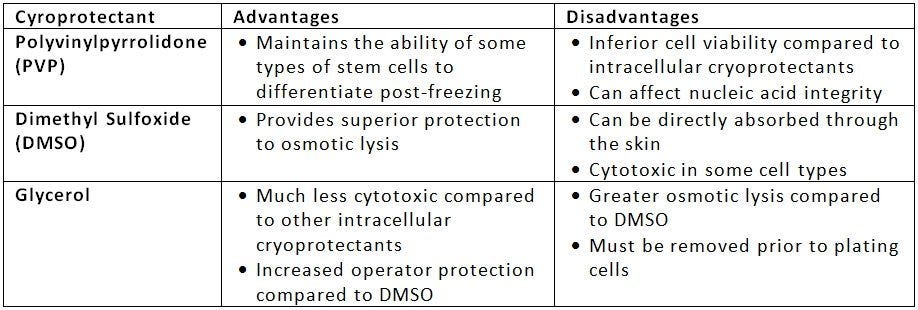
Learn about cryogenic storage and transport products offered by Laboratory-Equipment.com.
See our top-tier laboratory refrigerators and freezers.



